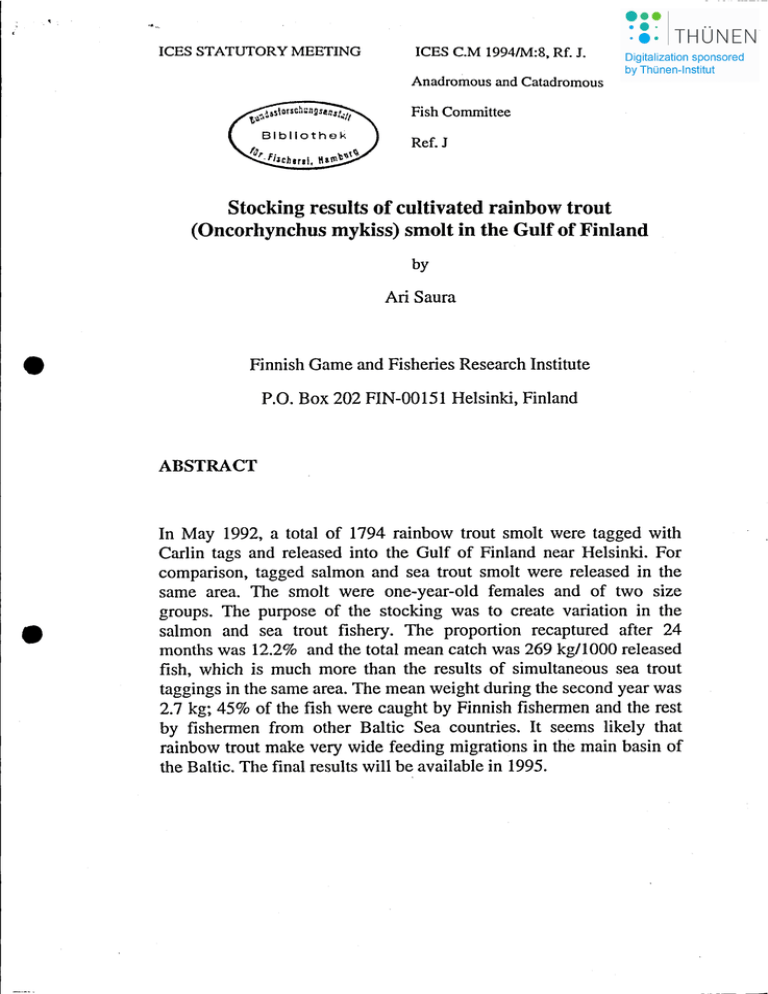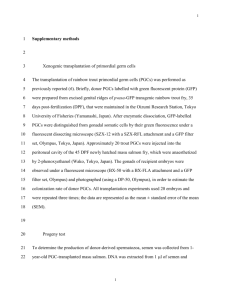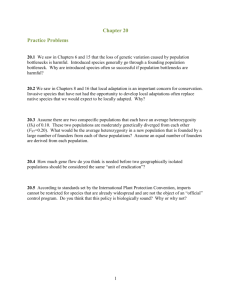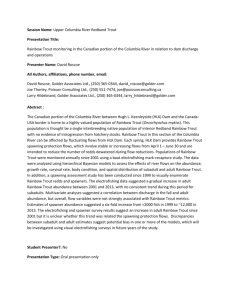• Stocking results of cultivated rainbow trout
advertisement

ICES STATUTORY MEETING ICES C.M 19941M:8. Rf. J. Anadromous and Catadromous Fish Committee Ref.J Stocking results of cultivated rainbow trout (Oncorhynchus mykiss) smolt in the Gulf of Finland by Ari Saura • Finnish Game and Fisheries Research Institute P.O. Box 202 FIN-OOI51 Helsinki, Finland ABSTRACT • In May 1992, a total of 1794 rainbow trout smolt were tagged with Carlin tags and released into the Gulf of Finland near Helsinki. For comparison, tagged salmon and sea trout smolt were released in the same area. The smolt were one-year-old females and of two size groups. The purpose of the stocking was to create variation in the salmon and sea trout fishery. The proportion recaptured after 24 months was 12.2% and the total mean catch was 269 kg/lOOO released fish, which is much more than the results of simultaneous sea trout taggings in the same area. The mean weight during the second year was 2.7 kg; 45% of the fish were caught by Finnish fishennen and the rest by fishermen from other Baltic Sea countries. It seems likely that rainbow trout make very wide feeding migrations in the main basin of the Baltic. The final results will be available in 1995. , . 2 Introduction The rainbow trout has been cultivated in Finland for direet consumption for about thirty years . Inland, it is cultivated along large water courses in fish-farm ponds and on the coast in net cages; fish escaped from the net eages have grown very quickly in the sea. "Put and take" angling has also become very popular during recent years. Fish of anglirig size have been released into small lakes, rivers, and even to the sea. Stoeking with smolt-size rainbow trout has been rare and unsuccessful. Tagging and stocking • On May 15, 1992, a total of 1794 Carlin-tagged rainbow trout smolt w~re released into the Gulf of Finland about 15 km west of Helsinki, in the Espoo archipelago. The smolt were one-year-old females cultivated in central Finland for commercial food fish produetion, tagged one week before release and transported to the sea in a tank truck .There were two size groups with mean lengths of 235 and 248 mm. Tagged salmon and sea trout smolt were simultaneously released in the same area (Table 1). . Table 1. Number and mean size of tagged rainbow traut, salmon, and sea traut. Numtg • 10IQlh fv1Eol fv1Eol W3igat mm 0 Rdnbow trout smdl€! lag8f 897 897 235 284 161 286 Sdmon Seatrout 999 997 203 237 99 140 Results The mean proportion of rainbow trout recaptured after 24 months was 12.2% and the total catch 269 kg/l000 released fish, whieh is the same level as that of salmon and mueh greaier than that of sea trout (Table 2). During the first year the smaller smolt produced a catch of 33 kg/IOOO released fish more than did the larger smolt.The reason may be that gill net fishing for pikeperch in the archipelago preferentiallY eaptures larger smolt during the first year in the sea. The smaller fish 3 are better able to eseape through the gill nets toward the offshore areas, where thc growth rate is faster and mueh of the eateh is taken with drift nets (Fig. 1). During the first year after release the rainbow trout eateh was larger than that of salmon or sea trout; the mean size was larger, too: ..Tbe mean weight of rainbow trout during the seeond year was 2.6 kg, which was more than that of sea trout but less than that of salmon. Tbe size of the fish varied widely (Table 2 and Fig. 2). Of these fish 45% were caught by Finnish fishermen, 38% by Danish fishermen and the rest by fishermen from other Baltie Sea eountries (Sweden, Germany, Poland, Estonia, and Latvia; Fig.3). • Rainbow trout seem to migrate veiy quiekly toward the south. Most reeaptures were made in offshore areas of the Gulf of Finland and 'Baltic main basin (Fig. 4). Tablc 2. Results of rainbow trout smolt tagging experiment comparcd with respectivc tagging of salmon and sea trout during 24 moriths after release. Firstyear Secondyear % % mean mean of weight of weight kg kg return return • Total % of return Proportion I returned (%) released by Finnish kg fishermen Catchl 1000 Rainbow trout smaller larger 3.2 4.9 1.6 1.2 9.3 6.9 2.5 2.8 12.5 11.8 285 252 45.3 45.4 Salmon Sea trout 1.0 1.0 1.2 0.7 6.2 1.3 3.7 2.1 7.2 2.3 244 34 90.7 96.2 Discussion It seems likely timt rainbow trout make very wide feeding migrations in the main basin of the Baltie, as about 47% of the reeaptures were made in the Gulf of Finland and almost a11 others in the main Baltie basin~ The profit for Finnish fishermen is less than from salmon and sea trout; only 5-15 % of the reeaptures of these species .were made outside the GiIlf of Finland. Aeeording to Bartel (1985 a), rainbo\v trout tagged in Poland migrated throughout the Baltie, but most were eaught in Polish coastal waters. Of the rainbow trout released iilto the Oslofjord and River Ims in Norway, 88% arid 69%, respectively, were taken at a distanee <50 km from the release sites (Jonsson et a1. 1993). .... 4 According to the results, 24% of the smaller and 41 % of the iarger rainbow trout were criught during the first year after release. On the Norwegian coast, 70 - 80% of the rainbow trout recaptures were taken in the year ofrelease (Jonsson et al. 1993). • Tbe rainbow trout seems to be. a very' useful fish species for sea ranching. Production of all-female groups is easy and the smolt are cheaper to produce than salmon or sea trout smolt. Tbe females grow more quickly and the quality of the meat is beUer. than that of males.Tbe return percentage and the catch/l000 released fish seem ,to be at a high level. In Poland, stocking with rainbow trout smolt in the Baltic is economically profitable (Bartel 1985 b). Tbe weakriess in Finland is that the local profit is not as good as with salmon and sea trout, which do not migrate in as wide an area. Protection of the natural salinon stocks in the Baltic mayaIso become a problem for rainbow trout fishing, because both species are caught simultarieously with the same fishing gear in one area. Rcfcrcnccs Barte), R. 1985 a. Distribution und migrations of tagged rainbow trout (Salmo Gairdlleri Rich.) released to the Baltic sea . Acta Ichthyologica et piscatoria. Vol. XV Fase. Suppl. Szczecin. Barte), R. 1985 b. Effeetiveness of stoeking tagged rainbow trout (Salmo Gairdlleri Rieh.) into the Baltie sea. • .Jonsson, N., Jonsson, B., Hansen, L. P. arid Aass, P~ 1993. Coastal movement and growth of domesticated rainbow trout (Ollcorhynchus mykiss (Walbaum» in Norway. Ecology ofFreshwater Fish 2: 152-159. Denmark. Legends to the figures Figure 1. Pereentages of reeaptures by fishing gear for rainbow trout. (A) smaller and (B) larger smolt, (C) salmon and (D) sea trout during 24 months after release. Figure 2. Weights (g) of reeaptured fish during 24 months after release. (A) smaller and (B) larger rainbow trout smolt, (C) salmon and (D) sea trout. Figure 3. Cumulative rainbow trout reeaptures in numbers by country during 24 months after release. Figure 4. Sites of release and recapture of rainbow trout in Baltic. Rod and line Rod and line 3 5 Longline 5 GilJ net 49 GilJ net 37 A B Trap net 6 Rod and tine 3 Gill net 16 Longline 34 c D e 6000 7000 6000 5000 A '-' 3000 · I · 1000 B '-' 8 • 3000 2000 5 10 15 20 25 •• 8 • • 1000 8 • 0 0 §• 3 8 8• 0 •• • 4000 • 8 • • •• : 8 ••• ··.: . ·...!'. · · ·• 2000 5000 ·•• ..• · 4000 3 0 • 5 10 15 20 25 20 25 MONTH MONTH 5000 8000 7000 4000 C 6000 D 8 • 5000 3000 .. ·• • .. '-' 4000 '-' 8 § 3000 • • ! 2000 • •• 2000 8 • 8 • 1000 1000 0 0 5 10 15 MONTH f\~ Z. 20 25 0 0 5 10 MONTH 15 CUMULATIVE RECAPTURES IN NUMBERS CUMULATIVE RECAPTURES IN NUMBERS 60r-----------------------, 60r----------------------, 50 50 . 40 .. 30 . 10 1.111.' o 40 2 4 .. 30 .. 20 . . . . 20 Ln 6 ln 8 10 12 14 16 18 20 22 24 ':H:~ l .~ ~ ~ 2 4 MONTH AFTER RELEASE _ FINLAND m DENMARK 0 6 8 10 12 14 16 18 20 MONTH AFTER RELEASE OTHER _ OTHER: Estonia. LaMa. Poland. FINLAND nm DEN MARK 0 OTHER OTHER: Estonia. Latvia. Poland. Sweden. Germany large smolt . .. Sweden. Germany small smolt 22 24 • • -Ftca LI.







